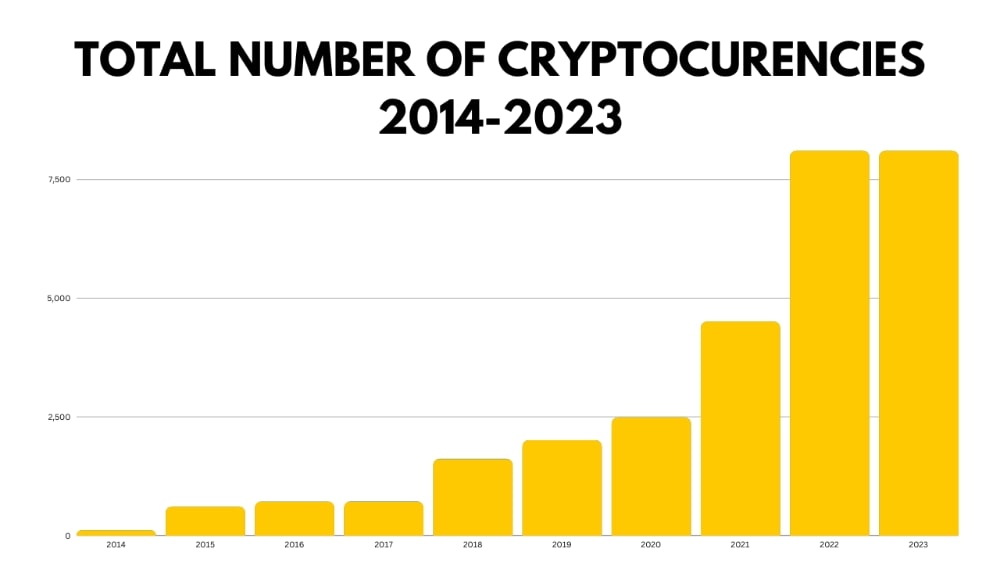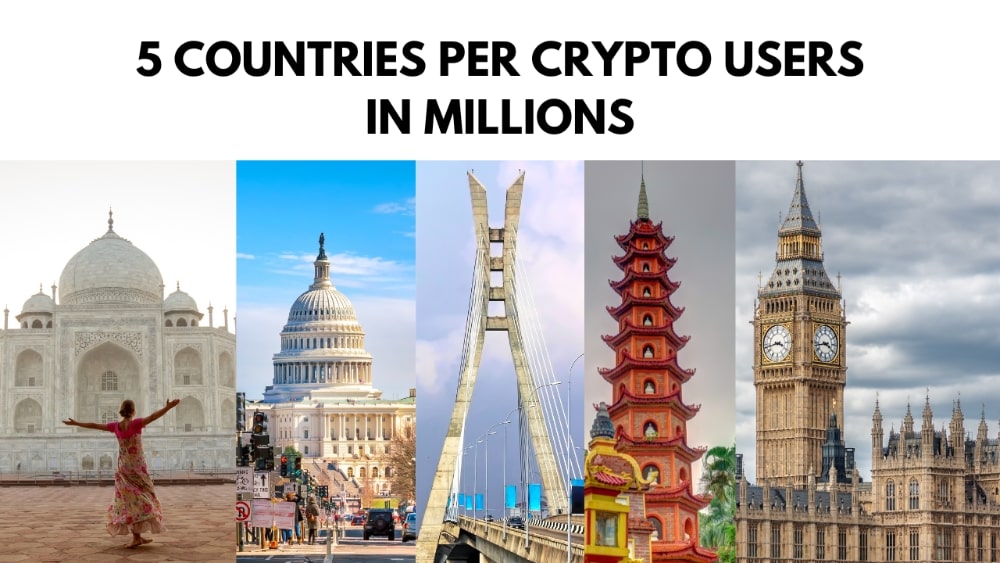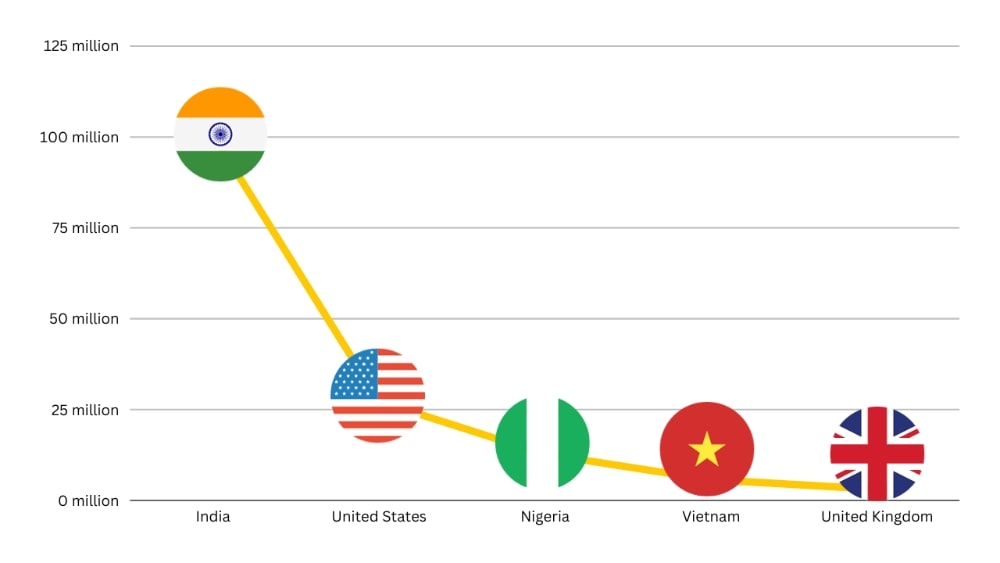Cryptocurrencies are all over the place and have experienced exponential growth since Bitcoin’s launch in 2009. Everywhere you look, you are likely to come across some kind of crypto coin or token, especially on social media. New ones emerge every day and you probably wondering why are there so many cryptocurrencies.
In this article, I will explain the reason behind this which includes exploring innovations, special use cases, technological advancements, and incentives that contribute to the proliferation of new cryptocurrencies.

According to Coinmarketcap as of December 2023, there were 8864 cryptocurrencies with a total market cap of $1.62 Trillion. Of these currencies, with over 300 million users and over 18,000 businesses accepting crypto as payment. Below is a graph showing the number of active cryptos as of 2025.

Cryptocurrencies can be defined in various ways including:
- Means of exchange
- Units of account
- Stores of value and,
- Digital assets.
As most of us know, Bitcoin was the first officially recognized cryptocurrency that was launched in 2009. All other cryptos developed since then are known as alt-coins with thousands currently in the market today.
Since 2021, it has been common for up to 1,000 currencies to be launched every day. Investors need to perform their due diligence when deciding which cryptos to invest in. When choosing the best option they usually wonder why are there multiple cryptocurrencies.
Reasons for Cryptocurrency Development
There is steady growth in the industry with investors looking for alt-coins to invest in daily. Some of the reasons these digital assets are constantly being created are:
Minimal Government Regulation
Buying and selling tokens can be done without governmental regulations. Regulations have been blamed for inefficient transactions and for reducing the speed of the transactions.
The lack of regulation has also attracted several scammers or creators of sham tokens. These are sometimes connected to Ponzi schemes that are attracted by the growth of the global crypto market cap.
Special Use-Cases
Developers are creating cryptocurrencies to leverage blockchain technology and revolutionize areas such as finance, health, IT, energy, and, logistics. In addition to being used as a medium of exchange, advancements in blockchain technology have been proven as a versatile way to tailor cryptocurrencies for specific sectors.
An example is the development of Ripple XRP which is used to facilitate cross-border payments for financial institutions.
New cryptos are invented to fill an existing gap that current cryptos don’t fill. For example, Bitcoin had some privacy issues hence coins such as Zcash and Monero (XMR) which have additional privacy and anonymity features were developed.
This is known as the ‘problem border’. When one crypto experiences a problem such as security or speed, new cryptos will be produced to fill that gap.
Technological Advancements & Innovation
With the spread of information regarding Web 3, more coders and developers are using blockchain to create products and services that bolster the crypto space. There has been a push towards innovation to develop new cryptocurrencies each with a unique use case and features.
Open-Source Nature of Blockchains
The underlying code of many blockchains is available to the public. This makes it easy for developers to scrutinize the code and modify it as they wish. This means there has been an increase in collaboration and competition among developers in a bid to create new currencies.
Creation of new cryptos is a fairly easy process and this leads to an influx of new digital assets. In addition, developers can create currencies and tokens just for fun or simply out of curiosity.
Financial Incentives
Consumers are moving away from traditional fiat currency to decentralized finance to work as a counterbalance. Cryptos are also unique alternative assets for investors to diversify their portfolios.
67% of all millennials view cryptocurrencies as a safe haven asset meaning they will retain value even during an economic downturn or during economic uncertainties. 97% of 60,000 respondents view cryptocurrency as a safe income-earning investment opportunity.
More and more businesses worldwide are accepting cryptos for various transactions. This results in more people using Bitcoin to make purchases with an average of $6 billion in daily transactions. Because of their decentralized nature, cryptos offer an advantage to bank account holders who will no longer have to shoulder transaction expenses.
Community & Ideological Differences
Most cryptos are built within a community that forms around blockchain projects. Each community has its own ideas of what the blockchain should do and they might disagree with the masses regarding issues such as governance, privacy, or blockchain scalability.
Different cryptocurrencies are then created to address these issues with coins and tokens splitting or expanding on existent digital assets.
These are just some of the reasons why there are many cryptocurrencies out there, with new ones being developed every day. As an investor or trader, you will need to find cryptos that show potential or those that are already established.
Who are the Crypto Users?

Cryptocurrencies are available worldwide although some people may have easier access to them. For example, for users in parts of Africa, there is little or no Internet coverage. This means crypto traders have to use alternative methods for trading crypto.
Below is a table showing the top five countries per crypto users in millions.

| Country | Number of Crypto Users |
|---|---|
| India | 100.7 million |
| United States | 27.5 million |
| Nigeria | 13 million |
| Vietnam | 6 million |
| United Kingdom | 3.4 million |
In addition, the number of crypto exchanges has increased as the number of currencies increases. As of March 2023, there were 569 exchanges and with some research, I found out that the top five were:
- Binance with 391 coins
- Coinbase with 245 coins
- Kraken with 222 coins
- KuCoin with 811 coins and
- Gate.io with 1,631 coins.
Also known as cryptocurrency payment gateways, these services let you purchase products from merchants who accept that specific currency.
Top Five Cryptos Beyond Bitcoin
Most cryptocurrencies are spinoffs from the original crypto – Bitcoin. Although Bitcoin is the most popular and remains the most recognized, several prominent players offer unique features that can be used per their specific functionalities.
They all contribute something special to the cryptocurrency ecosystem and here, I will briefly go over the top five cryptos that investors might be interested in.
Ethereum (ETH)
Ethereum revolutionized the crypto world with the introduction of smart contracts. These contracts allow developers to build decentralized applications (DApps) and decentralized autonomous organizations (DAOs) on the network.
These capabilities have made Ethereum a foundational element of Decentralized Finance (DeFi) and non-fungible token (NFT) sectors. Some key features of the
Ethereum blockchain includes:
- Smart contract functionality.
- Improved scalability.
- Energy efficiency.
- Rapid development of DeFi and DApps projects.
Binance Coin (BNB)
Binance Coin is the original cryptocurrency native to the Binance Exchange. It has grown significantly over the past few years. Having been launched as an ERC-20 token on the Ethereum blockchain, it has since moved to Binance’s own blockchain known as Binance Chain.
Binance Coin offers reduced trading fees on the chain and allows for token sales on Binance Launchpad.
It also powers the Binance Smart Chain (BSC) which is compatible with Ethereum at a lower fee. Key features include:
- Utility within the Binance networks including BSC.
- Lower trading fees on Binance.
- Support for DApps and DeFi projects.
Cardano (ADA)
Cardano is known for its peer-reviewed development model. It was created by Charles Hoskinson of Input Output Hong Kong (IOHK). The crypto is aimed at being scalable and secure with a two-layer architecture.
The separation between the Settlement Layer (CSL) and the Computation Layer (CCL), allows for more flexibility and long-term sustainability. The key features offered by Cardano include:
- An academic, peer-reviewed approach to development
- A two-layer architecture to increase scalability and security.
- A unique focus on sustainability and interoperability.
Solana (SOL)
Solana is one of our favorite networks and is known for its high transaction processing speeds and low fees. Its speed and scalability features make it ideal for DeFi projects and DApps development.
It also uses a Proof of History (PoH) along with a Byzantine Fault Tolerance (PBFT) Consensus. This unique consensus system is different from most Proof of Work (PoW) consensus methods.
Solana’s key features include:
- High output and low transaction fees.
- Innovative consensus mechanisms to promote scalability.
- Attractive blockchain for DeFi and NFT project development.
Polkadot (DOT)
Polkadot is a multi-chain network that connects different blockchains. It allows them to interact and securely share information.
Defined as a para chain, it was developed by a previous Ethereum developer and features technology that allows developers to create custom blockchains which are then connected to the main Polkadot network.
This sets the stage for interoperability and the creation of a diverse ecosystem of connected blockchains.
Key features of the Polkadot chain include:
- Interaction between blockchains.
- Increased flexibility and scalability through parachains.
- Governance and self-upgrading capabilities.
These are the top five cryptos apart from Bitcoin that have created strong communities around them and could be a good investment alternative. They are likely to remain at the head of innovation even as the crypto landscape rapidly evolves.
Types of Cryptocurrencies
Cryptos can either take the format of coins or tokens. Those that are developed as better versions of Bitcoin are known as alt-coins. These are essentially improved versions of Bitcoin that are generally free from government regulations and are committed to remaining decentralized.
Tokens are based on blockchains like coins but are not meant to serve as digital money. Some are issued as part of an Initial Coin Offering (ICO) and represent an investor’s stake in a blockchain. If they are linked to the value of a new company or project, they are known as security tokens.
Utility tokens serve different functions such as Storj tokens that allow you to share files through a decentralized network. Another function is usage as a Domain Name System service for Internet addresses. These tokens however they are used all tend to trade on exchanges in the same way.
Bottom Line
An increasing number of cryptocurrencies are appearing in the world. If you ask me, do we need them in such quantities? Personally, my answer would be no. Nevertheless, many crypto projects have really useful features, which gives me confidence that blockchain technology itself is here to stay and will develop along with top currencies. But, at the same time, I am sure that the number of cryptocurrencies will decrease soon, since in the coming years we will face regulations that will make the rules of the game more understandable, but also more difficult to implement, which will save us from the abundance of useless coins that only come out to collect their own “hype”, and with it the money of the “hamsters”.
Disclaimer: The content presented is for informational purposes only and does not constitute financial, investment, tax, legal, or professional advice. If any securities were mentioned in the content, the author might hold positions in the mentioned securities. The content is provided “as is” without any representations or warranties, express or implied.
